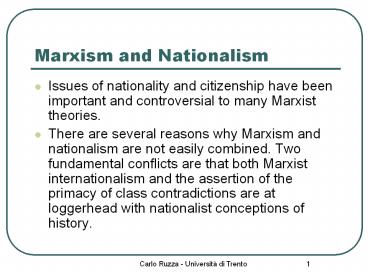Marxism%20and%20Nationalism - PowerPoint PPT Presentation
Title:
Marxism%20and%20Nationalism
Description:
It is against this national bourgeoisie that the proletariat can then rebel. ... National symbols, such as flags and anthems became central to action repertoires. ... – PowerPoint PPT presentation
Number of Views:110
Avg rating:3.0/5.0
Title: Marxism%20and%20Nationalism
1
Marxism and Nationalism
- Issues of nationality and citizenship have been
important and controversial to many Marxist
theories. - There are several reasons why Marxism and
nationalism are not easily combined. Two
fundamental conflicts are that both Marxist
internationalism and the assertion of the primacy
of class contradictions are at loggerhead with
nationalist conceptions of history.
2
Marx and Engels
- Some scholars argue that marx was contradictory
in his views of nationalism. - As Nimni argues (Marxism and nationalism, Pluto
1991), Marx and Engels thinking was ambivalent
but well developed. - For Marx, nationalism is epiphenomenal.
State-building and an advanced economy require
nation-building, which is therefore essential to
the formation of a bourgeoisie. It is against
this national bourgeoisie that the proletariat
can then rebel.
3
Nations without History
- If the function of nationalist mobilisation is to
form nation-states, national movements that are
ineffective because too small or too weak come to
be seen as regressive. - These are nations without history.
- They hinder the progress of history towards a
proletarian revolution. They distract the energy
of the proletariat.
4
Marxist intolerance of ethnic minorities
- Whilst some national questions are well examined
by Marx an Engels - such as the Irish question
for other minorities there is hostility.
North-African Bedouins, Chinese, Scandinavians,
Spaniards and Mexicans are seen with scorn. - Conversely, the Irish question is seen as
important and in need of a solution because it
engenders rivalry within the proletariat. - A separate Irish state would create a
contradiction between proletariat and
bourgeoisie, and therefore the premises of a
revolution. - Thus there is no intrinsic contradiction in the
Marxist position (Nimni 1991).
5
Marxist Reductionism
- The reductionist approach of Marx and Engels was
faithfully followed during the Second
International. Various forms and justifications
of reductionism appear in Kautsky, Luxemburg,
Bernstein, Lenin and Stalin. - For Lenin there is no national culture, only an
illusion of it, which is due to bourgeois
mystification. Every nation has two cultures, a
bourgeois one and a proletarian one. - Nationalist movements need to be encouraged only
when and as long as they advance the forces of
production.
6
Gramsci
- Gramsci is the first Marxist who clearly rejects
economic and class reductionism. - Gramsci connects nationalism to internal
colonialism, and proposes the concepts of
hegemony, historical bloc, and organic
intellectuals in relation to the concept of
nation.
7
The New Left and Nationalism
- Gramscian Marxism was central to much of the new
left thinking. - However, reductionist views still survived in the
new left engendering controversial debates on the
nature, scope and future of nationalism. - Part of the new left simply chose to ignore
nationalism and abandoned it to the right.
8
The new left as a social movement
- As a social movement, in several countries, the
new left defined itself in contraposition to the
extreme right. Nationalism versus proletarian
internationalism, or more generally
multi-culturalism came to form the dividing line
between movement and counter-movement. - Nationality and nationalism became therefore a
contentious issue. National symbols, such as
flags and anthems became central to action
repertoires.
9
FrontiersRepression
- As Katsiaficas (1987, p. 104)notes, the slogans
and ethos of the new left was militantly
anti-nationalist everywhere. - Nationalism was seen as an exclusionary doctrine
that divided the working class. - Pro-immigrant sentiments were voiced, bilingual
posters seek to integrate foreign workers in
protest events.
10
RM and the New Left
- With its strong focus on organizational factors
and resources, RM echoes the ideology of the new
left. - Some analysts of the NSM school say that RM is in
fact only applicable to the movements of the New
Left - The New Left constituted a set of ideologically
similar movements which diffused throughout the
Western world and in some developing countries in
the late sixties and seventies. It has been
called a World-Historical Movement.































